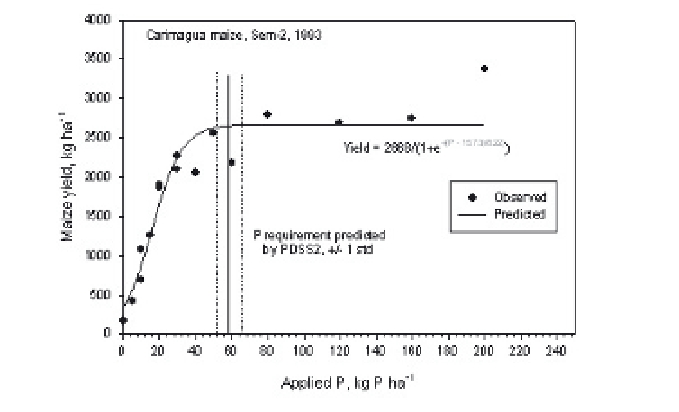Information Technology Reference
In-Depth Information
PCL = P critical level of the crop using a specific extractants (“Soil P required”of eq. 3)
Po = Initial, measured soil level of P using an specific extractant (“Soil P present” of eq. 3)
PBC = Phosphorus Buffer Coefficient using a specific extractant (“Reactivity of the soil to
added P” of eq. 3)
Puptake = Yield of crop component removed*P content of the removed tissue (not present in
eq. 3)
Application depth = Depth to which the fertilizer is incorporated (not present in eq. 3)
Placement factor = A factor that represents the relative efficiency of localized placement in
reducing the P fertilizer requirement (not present in eq. 3)
The predictions developed in PDSS, as in ACID4, also included an expression of the
associated uncertainty. In the ACID4 and FARMSYS modules the uncertainties were
personal estimates of the reliability of the rules being exercised. In PDSS a different
approach was used, that of error propagation (Burges and Lettenmaier, 1975). The error
propagation calculation resulted in a very useful assessment of the equation's prediction.
This was later expressed as the confidence limits of the prediction. An example of a
prediction of P requirement was carried out on an experiment done at the Centro
Internacional de Agricultura Tropical (CIAT) in Cali, Colombia and is illustrated in Figure 2.
An interesting result of this prediction was that the actual precision of the fertilizer
prediction was approximately +/- 50% of the requirement in most cases. This large error
pointed out the typically large uncertainty in fertilizer predictions. One advantage of the
first order uncertainty prediction was the ranking of sources of variability in the prediction
equation. This enabled prioritizing research effort to better understand and make
predictions (Chen et al., 1997).
Fig. 2. Comparison of PDSS prediction with field estimates of the amount of fertilizer
phosphorus needed to achieve maximum yield (CIAT, 1993)
6.3.7 Economic analysis
Economic analysis was the third component. This component clearly differed from the other
portions of the decision making process requiring an economic calculation of profitability
resulting from resolving the Diagnosed problem using the Prediction methodology. As


Search WWH ::

Custom Search